Comprehensive Online Exam: Auditing Concepts, Procedures, and Software
VerifiedAdded on 2022/12/30
|8
|2107
|45
Homework Assignment
AI Summary
This document presents a comprehensive solution to an online auditing exam, addressing several key areas. It begins by defining subsequent events and contingencies, explaining their impact on financial statements and the audit process, including required disclosures and audit procedures for probable contingent liabilities. The solution then explores auditor independence, identifying threats such as self-interest, self-review, familiarity, and intimidation, and provides scenarios illustrating how these threats can compromise objectivity. Audit evidence, including bank loan receipts, management assumptions, and market research reports, is examined, along with audit procedures for obtaining and evaluating sufficient appropriate evidence. The document also addresses internal control issues, such as confidentiality breaches, inconsistent accounting policies, and supplier statement reconciliation. It also provides audit procedures for vehicles and bungalows. Finally, it analyzes the problems associated with using audit software and discusses the concept of auditing around the computer, highlighting potential risks and considerations for auditors.
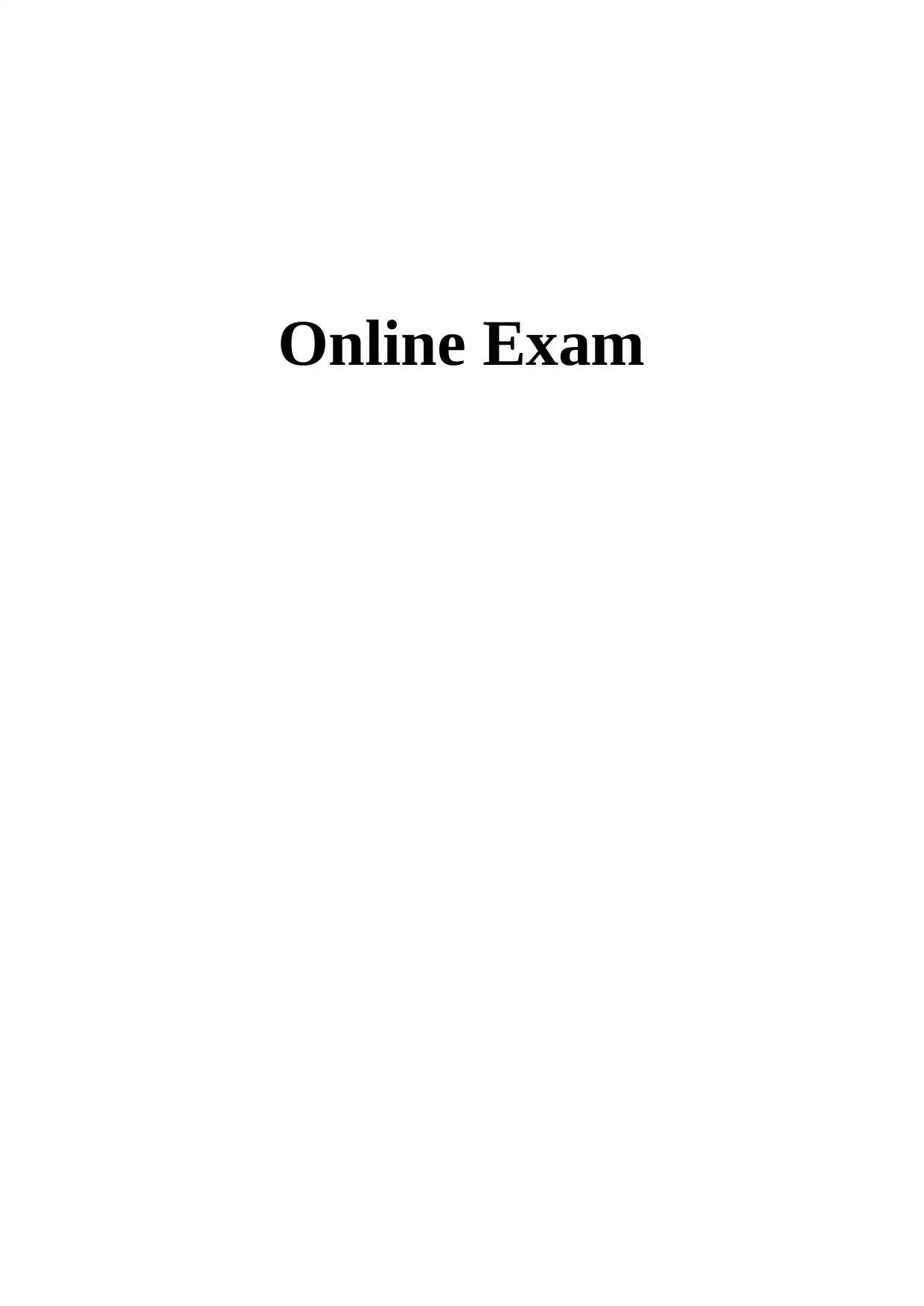
Online Exam
Paraphrase This Document
Need a fresh take? Get an instant paraphrase of this document with our AI Paraphraser
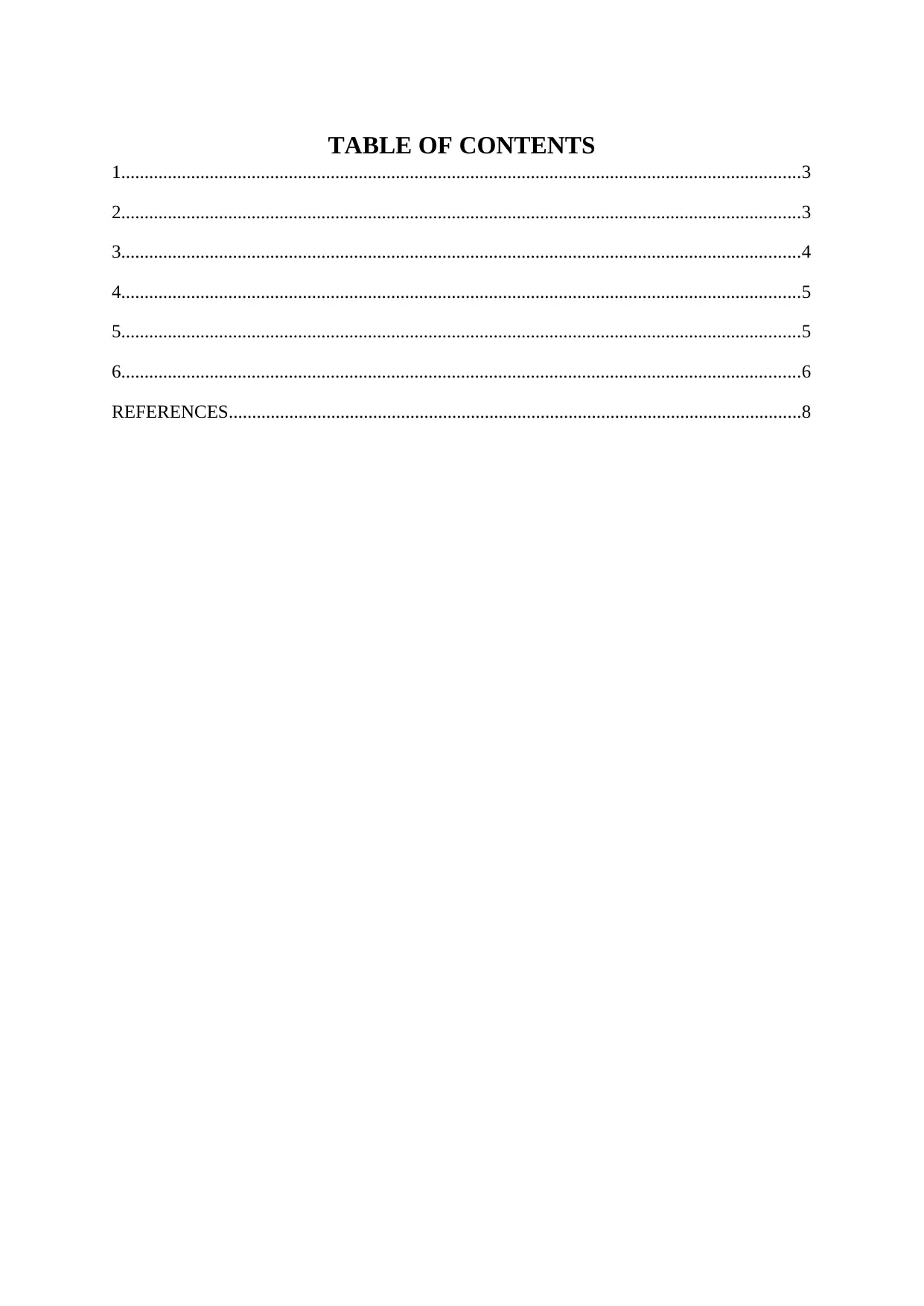
TABLE OF CONTENTS
1..................................................................................................................................................3
2..................................................................................................................................................3
3..................................................................................................................................................4
4..................................................................................................................................................5
5..................................................................................................................................................5
6..................................................................................................................................................6
REFERENCES...........................................................................................................................8
1..................................................................................................................................................3
2..................................................................................................................................................3
3..................................................................................................................................................4
4..................................................................................................................................................5
5..................................................................................................................................................5
6..................................................................................................................................................6
REFERENCES...........................................................................................................................8
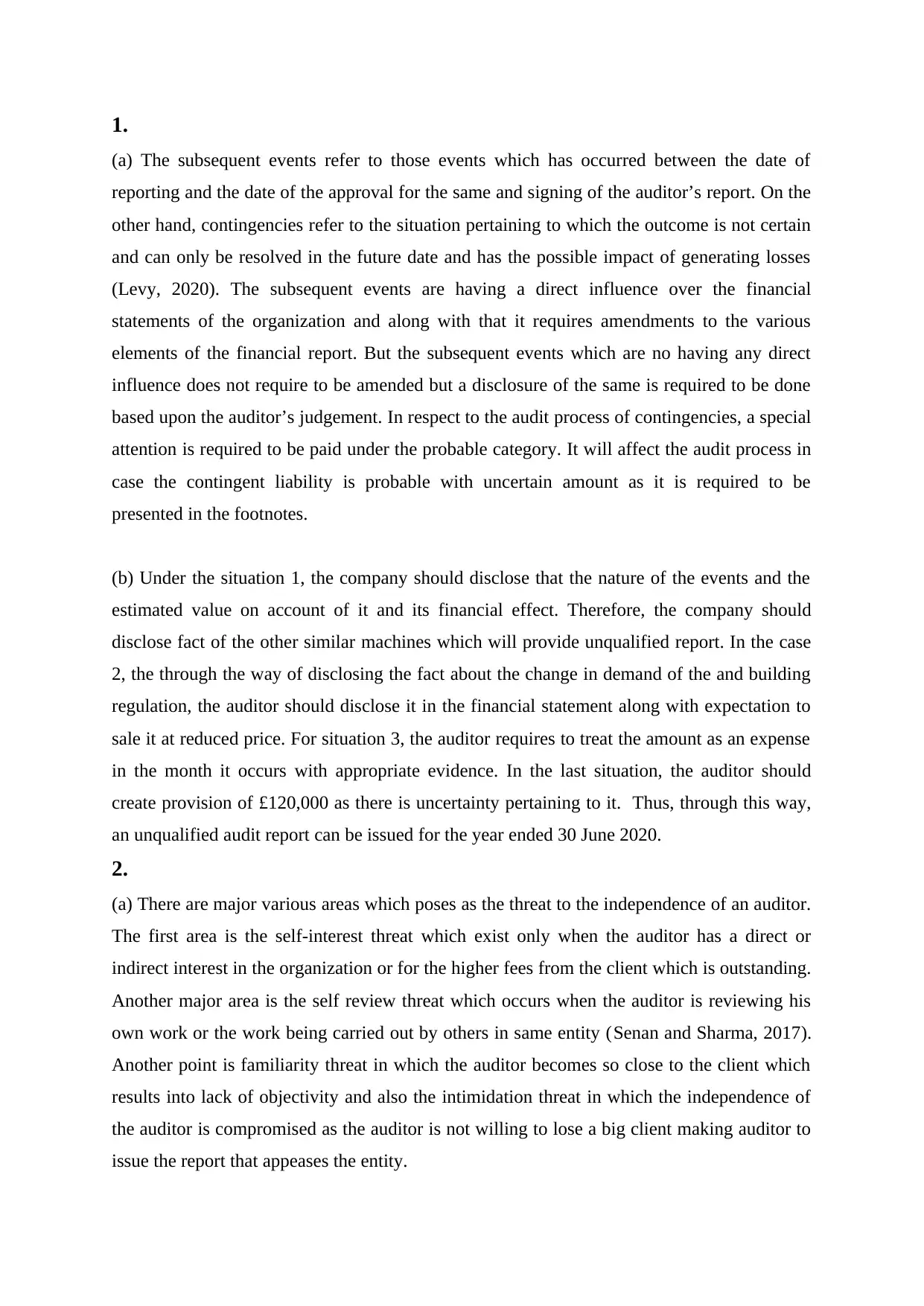
1.
(a) The subsequent events refer to those events which has occurred between the date of
reporting and the date of the approval for the same and signing of the auditor’s report. On the
other hand, contingencies refer to the situation pertaining to which the outcome is not certain
and can only be resolved in the future date and has the possible impact of generating losses
(Levy, 2020). The subsequent events are having a direct influence over the financial
statements of the organization and along with that it requires amendments to the various
elements of the financial report. But the subsequent events which are no having any direct
influence does not require to be amended but a disclosure of the same is required to be done
based upon the auditor’s judgement. In respect to the audit process of contingencies, a special
attention is required to be paid under the probable category. It will affect the audit process in
case the contingent liability is probable with uncertain amount as it is required to be
presented in the footnotes.
(b) Under the situation 1, the company should disclose that the nature of the events and the
estimated value on account of it and its financial effect. Therefore, the company should
disclose fact of the other similar machines which will provide unqualified report. In the case
2, the through the way of disclosing the fact about the change in demand of the and building
regulation, the auditor should disclose it in the financial statement along with expectation to
sale it at reduced price. For situation 3, the auditor requires to treat the amount as an expense
in the month it occurs with appropriate evidence. In the last situation, the auditor should
create provision of £120,000 as there is uncertainty pertaining to it. Thus, through this way,
an unqualified audit report can be issued for the year ended 30 June 2020.
2.
(a) There are major various areas which poses as the threat to the independence of an auditor.
The first area is the self-interest threat which exist only when the auditor has a direct or
indirect interest in the organization or for the higher fees from the client which is outstanding.
Another major area is the self review threat which occurs when the auditor is reviewing his
own work or the work being carried out by others in same entity (Senan and Sharma, 2017).
Another point is familiarity threat in which the auditor becomes so close to the client which
results into lack of objectivity and also the intimidation threat in which the independence of
the auditor is compromised as the auditor is not willing to lose a big client making auditor to
issue the report that appeases the entity.
(a) The subsequent events refer to those events which has occurred between the date of
reporting and the date of the approval for the same and signing of the auditor’s report. On the
other hand, contingencies refer to the situation pertaining to which the outcome is not certain
and can only be resolved in the future date and has the possible impact of generating losses
(Levy, 2020). The subsequent events are having a direct influence over the financial
statements of the organization and along with that it requires amendments to the various
elements of the financial report. But the subsequent events which are no having any direct
influence does not require to be amended but a disclosure of the same is required to be done
based upon the auditor’s judgement. In respect to the audit process of contingencies, a special
attention is required to be paid under the probable category. It will affect the audit process in
case the contingent liability is probable with uncertain amount as it is required to be
presented in the footnotes.
(b) Under the situation 1, the company should disclose that the nature of the events and the
estimated value on account of it and its financial effect. Therefore, the company should
disclose fact of the other similar machines which will provide unqualified report. In the case
2, the through the way of disclosing the fact about the change in demand of the and building
regulation, the auditor should disclose it in the financial statement along with expectation to
sale it at reduced price. For situation 3, the auditor requires to treat the amount as an expense
in the month it occurs with appropriate evidence. In the last situation, the auditor should
create provision of £120,000 as there is uncertainty pertaining to it. Thus, through this way,
an unqualified audit report can be issued for the year ended 30 June 2020.
2.
(a) There are major various areas which poses as the threat to the independence of an auditor.
The first area is the self-interest threat which exist only when the auditor has a direct or
indirect interest in the organization or for the higher fees from the client which is outstanding.
Another major area is the self review threat which occurs when the auditor is reviewing his
own work or the work being carried out by others in same entity (Senan and Sharma, 2017).
Another point is familiarity threat in which the auditor becomes so close to the client which
results into lack of objectivity and also the intimidation threat in which the independence of
the auditor is compromised as the auditor is not willing to lose a big client making auditor to
issue the report that appeases the entity.
⊘ This is a preview!⊘
Do you want full access?
Subscribe today to unlock all pages.

Trusted by 1+ million students worldwide
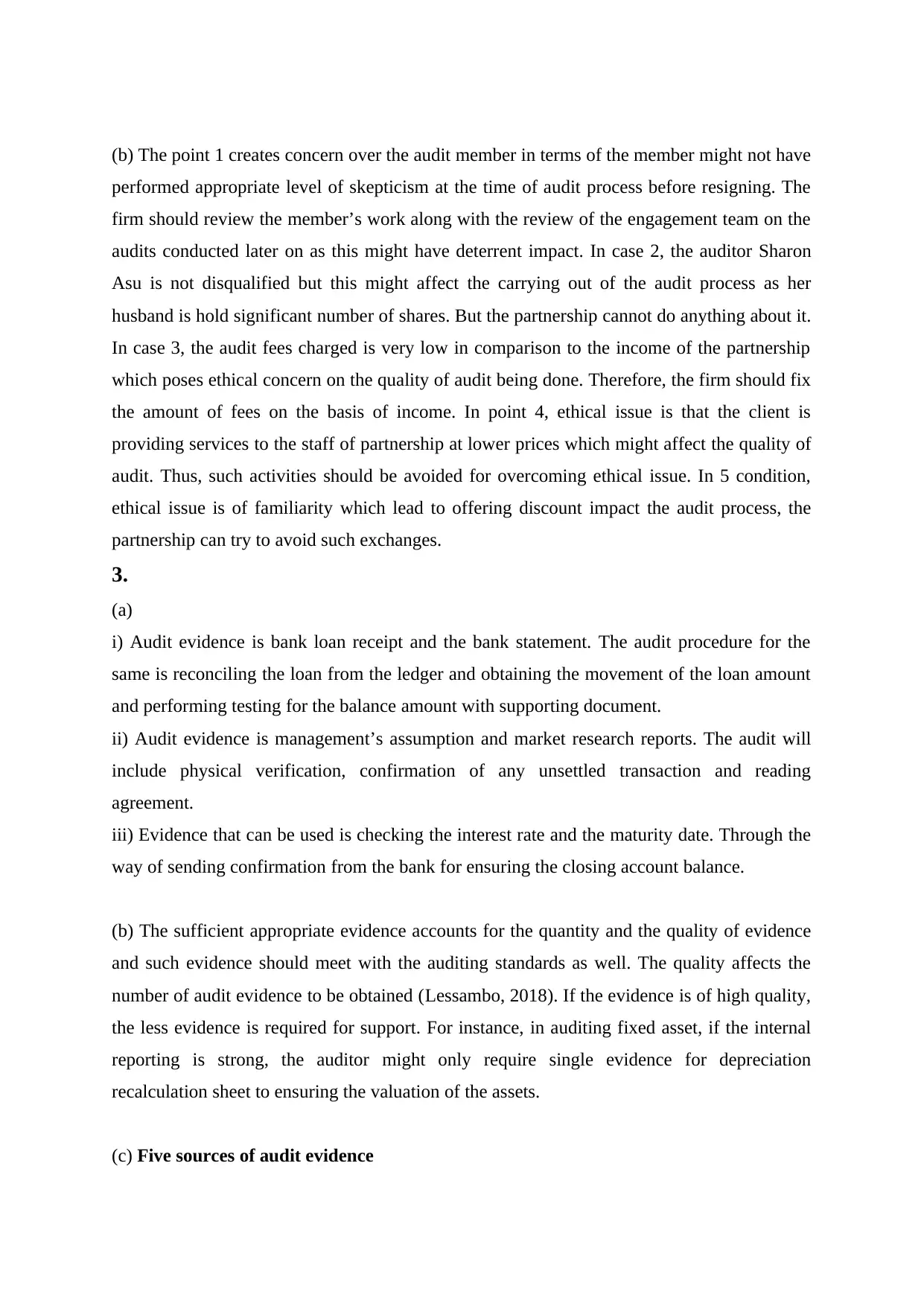
(b) The point 1 creates concern over the audit member in terms of the member might not have
performed appropriate level of skepticism at the time of audit process before resigning. The
firm should review the member’s work along with the review of the engagement team on the
audits conducted later on as this might have deterrent impact. In case 2, the auditor Sharon
Asu is not disqualified but this might affect the carrying out of the audit process as her
husband is hold significant number of shares. But the partnership cannot do anything about it.
In case 3, the audit fees charged is very low in comparison to the income of the partnership
which poses ethical concern on the quality of audit being done. Therefore, the firm should fix
the amount of fees on the basis of income. In point 4, ethical issue is that the client is
providing services to the staff of partnership at lower prices which might affect the quality of
audit. Thus, such activities should be avoided for overcoming ethical issue. In 5 condition,
ethical issue is of familiarity which lead to offering discount impact the audit process, the
partnership can try to avoid such exchanges.
3.
(a)
i) Audit evidence is bank loan receipt and the bank statement. The audit procedure for the
same is reconciling the loan from the ledger and obtaining the movement of the loan amount
and performing testing for the balance amount with supporting document.
ii) Audit evidence is management’s assumption and market research reports. The audit will
include physical verification, confirmation of any unsettled transaction and reading
agreement.
iii) Evidence that can be used is checking the interest rate and the maturity date. Through the
way of sending confirmation from the bank for ensuring the closing account balance.
(b) The sufficient appropriate evidence accounts for the quantity and the quality of evidence
and such evidence should meet with the auditing standards as well. The quality affects the
number of audit evidence to be obtained (Lessambo, 2018). If the evidence is of high quality,
the less evidence is required for support. For instance, in auditing fixed asset, if the internal
reporting is strong, the auditor might only require single evidence for depreciation
recalculation sheet to ensuring the valuation of the assets.
(c) Five sources of audit evidence
performed appropriate level of skepticism at the time of audit process before resigning. The
firm should review the member’s work along with the review of the engagement team on the
audits conducted later on as this might have deterrent impact. In case 2, the auditor Sharon
Asu is not disqualified but this might affect the carrying out of the audit process as her
husband is hold significant number of shares. But the partnership cannot do anything about it.
In case 3, the audit fees charged is very low in comparison to the income of the partnership
which poses ethical concern on the quality of audit being done. Therefore, the firm should fix
the amount of fees on the basis of income. In point 4, ethical issue is that the client is
providing services to the staff of partnership at lower prices which might affect the quality of
audit. Thus, such activities should be avoided for overcoming ethical issue. In 5 condition,
ethical issue is of familiarity which lead to offering discount impact the audit process, the
partnership can try to avoid such exchanges.
3.
(a)
i) Audit evidence is bank loan receipt and the bank statement. The audit procedure for the
same is reconciling the loan from the ledger and obtaining the movement of the loan amount
and performing testing for the balance amount with supporting document.
ii) Audit evidence is management’s assumption and market research reports. The audit will
include physical verification, confirmation of any unsettled transaction and reading
agreement.
iii) Evidence that can be used is checking the interest rate and the maturity date. Through the
way of sending confirmation from the bank for ensuring the closing account balance.
(b) The sufficient appropriate evidence accounts for the quantity and the quality of evidence
and such evidence should meet with the auditing standards as well. The quality affects the
number of audit evidence to be obtained (Lessambo, 2018). If the evidence is of high quality,
the less evidence is required for support. For instance, in auditing fixed asset, if the internal
reporting is strong, the auditor might only require single evidence for depreciation
recalculation sheet to ensuring the valuation of the assets.
(c) Five sources of audit evidence
Paraphrase This Document
Need a fresh take? Get an instant paraphrase of this document with our AI Paraphraser
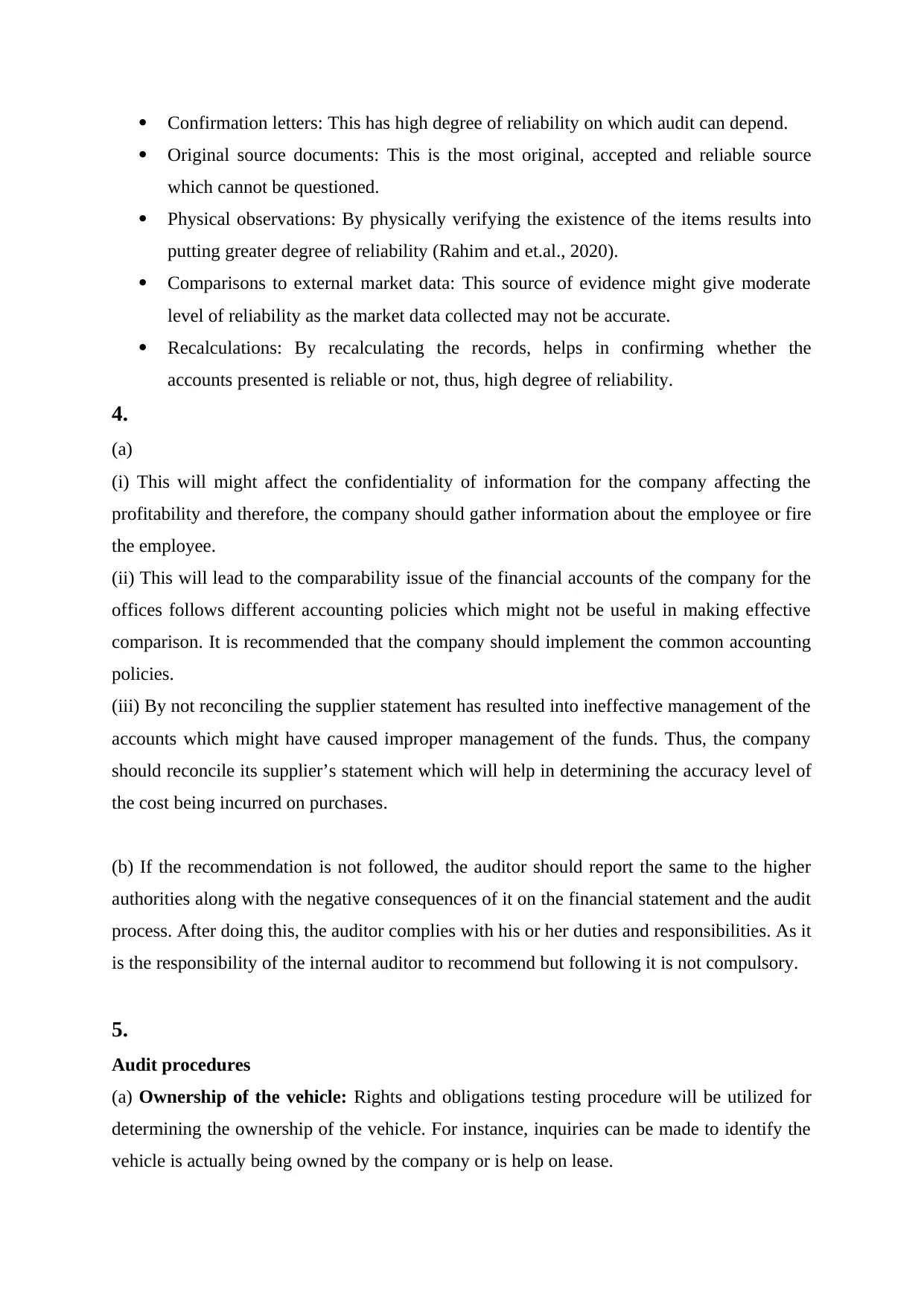
Confirmation letters: This has high degree of reliability on which audit can depend.
Original source documents: This is the most original, accepted and reliable source
which cannot be questioned.
Physical observations: By physically verifying the existence of the items results into
putting greater degree of reliability (Rahim and et.al., 2020).
Comparisons to external market data: This source of evidence might give moderate
level of reliability as the market data collected may not be accurate.
Recalculations: By recalculating the records, helps in confirming whether the
accounts presented is reliable or not, thus, high degree of reliability.
4.
(a)
(i) This will might affect the confidentiality of information for the company affecting the
profitability and therefore, the company should gather information about the employee or fire
the employee.
(ii) This will lead to the comparability issue of the financial accounts of the company for the
offices follows different accounting policies which might not be useful in making effective
comparison. It is recommended that the company should implement the common accounting
policies.
(iii) By not reconciling the supplier statement has resulted into ineffective management of the
accounts which might have caused improper management of the funds. Thus, the company
should reconcile its supplier’s statement which will help in determining the accuracy level of
the cost being incurred on purchases.
(b) If the recommendation is not followed, the auditor should report the same to the higher
authorities along with the negative consequences of it on the financial statement and the audit
process. After doing this, the auditor complies with his or her duties and responsibilities. As it
is the responsibility of the internal auditor to recommend but following it is not compulsory.
5.
Audit procedures
(a) Ownership of the vehicle: Rights and obligations testing procedure will be utilized for
determining the ownership of the vehicle. For instance, inquiries can be made to identify the
vehicle is actually being owned by the company or is help on lease.
Original source documents: This is the most original, accepted and reliable source
which cannot be questioned.
Physical observations: By physically verifying the existence of the items results into
putting greater degree of reliability (Rahim and et.al., 2020).
Comparisons to external market data: This source of evidence might give moderate
level of reliability as the market data collected may not be accurate.
Recalculations: By recalculating the records, helps in confirming whether the
accounts presented is reliable or not, thus, high degree of reliability.
4.
(a)
(i) This will might affect the confidentiality of information for the company affecting the
profitability and therefore, the company should gather information about the employee or fire
the employee.
(ii) This will lead to the comparability issue of the financial accounts of the company for the
offices follows different accounting policies which might not be useful in making effective
comparison. It is recommended that the company should implement the common accounting
policies.
(iii) By not reconciling the supplier statement has resulted into ineffective management of the
accounts which might have caused improper management of the funds. Thus, the company
should reconcile its supplier’s statement which will help in determining the accuracy level of
the cost being incurred on purchases.
(b) If the recommendation is not followed, the auditor should report the same to the higher
authorities along with the negative consequences of it on the financial statement and the audit
process. After doing this, the auditor complies with his or her duties and responsibilities. As it
is the responsibility of the internal auditor to recommend but following it is not compulsory.
5.
Audit procedures
(a) Ownership of the vehicle: Rights and obligations testing procedure will be utilized for
determining the ownership of the vehicle. For instance, inquiries can be made to identify the
vehicle is actually being owned by the company or is help on lease.
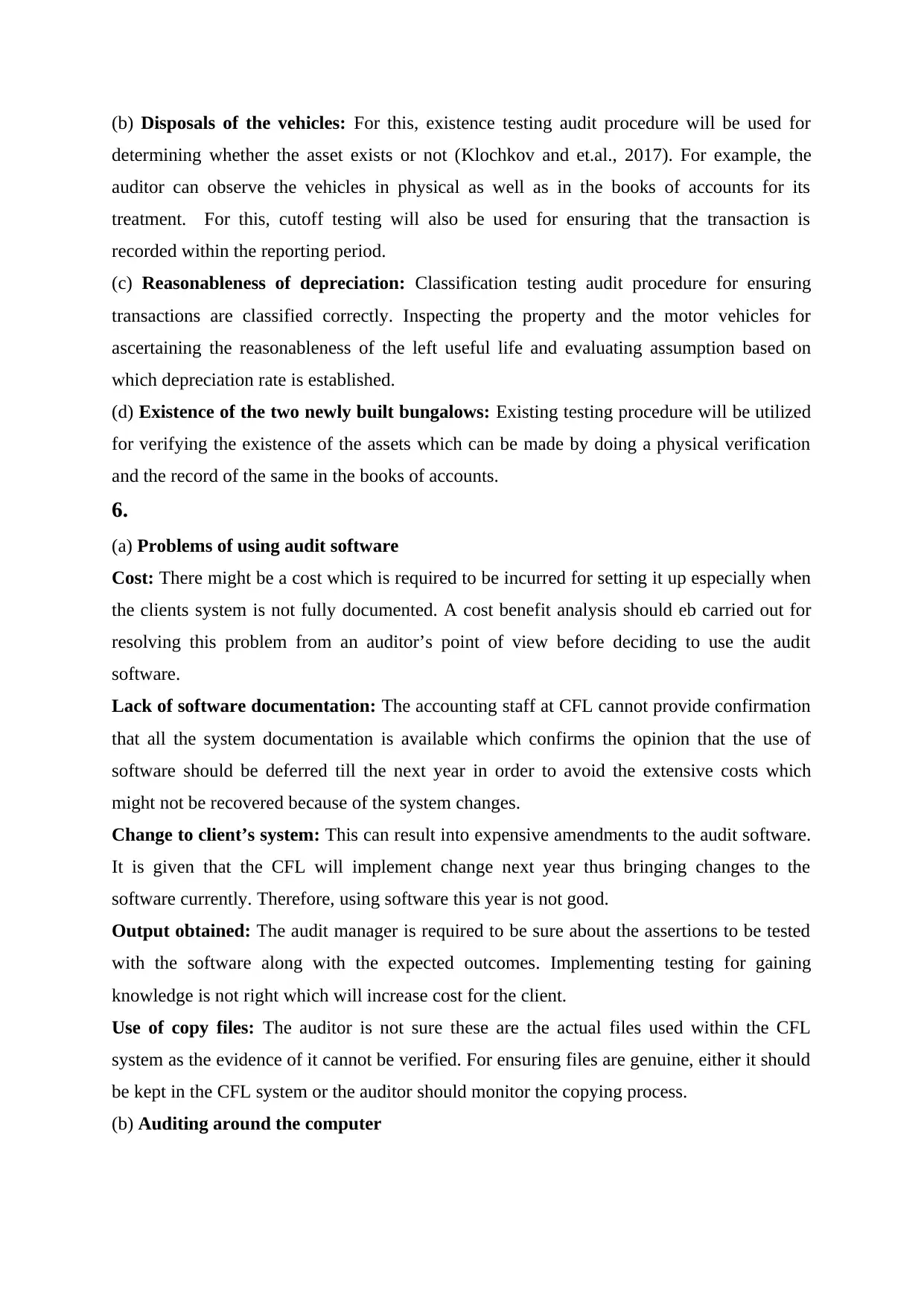
(b) Disposals of the vehicles: For this, existence testing audit procedure will be used for
determining whether the asset exists or not (Klochkov and et.al., 2017). For example, the
auditor can observe the vehicles in physical as well as in the books of accounts for its
treatment. For this, cutoff testing will also be used for ensuring that the transaction is
recorded within the reporting period.
(c) Reasonableness of depreciation: Classification testing audit procedure for ensuring
transactions are classified correctly. Inspecting the property and the motor vehicles for
ascertaining the reasonableness of the left useful life and evaluating assumption based on
which depreciation rate is established.
(d) Existence of the two newly built bungalows: Existing testing procedure will be utilized
for verifying the existence of the assets which can be made by doing a physical verification
and the record of the same in the books of accounts.
6.
(a) Problems of using audit software
Cost: There might be a cost which is required to be incurred for setting it up especially when
the clients system is not fully documented. A cost benefit analysis should eb carried out for
resolving this problem from an auditor’s point of view before deciding to use the audit
software.
Lack of software documentation: The accounting staff at CFL cannot provide confirmation
that all the system documentation is available which confirms the opinion that the use of
software should be deferred till the next year in order to avoid the extensive costs which
might not be recovered because of the system changes.
Change to client’s system: This can result into expensive amendments to the audit software.
It is given that the CFL will implement change next year thus bringing changes to the
software currently. Therefore, using software this year is not good.
Output obtained: The audit manager is required to be sure about the assertions to be tested
with the software along with the expected outcomes. Implementing testing for gaining
knowledge is not right which will increase cost for the client.
Use of copy files: The auditor is not sure these are the actual files used within the CFL
system as the evidence of it cannot be verified. For ensuring files are genuine, either it should
be kept in the CFL system or the auditor should monitor the copying process.
(b) Auditing around the computer
determining whether the asset exists or not (Klochkov and et.al., 2017). For example, the
auditor can observe the vehicles in physical as well as in the books of accounts for its
treatment. For this, cutoff testing will also be used for ensuring that the transaction is
recorded within the reporting period.
(c) Reasonableness of depreciation: Classification testing audit procedure for ensuring
transactions are classified correctly. Inspecting the property and the motor vehicles for
ascertaining the reasonableness of the left useful life and evaluating assumption based on
which depreciation rate is established.
(d) Existence of the two newly built bungalows: Existing testing procedure will be utilized
for verifying the existence of the assets which can be made by doing a physical verification
and the record of the same in the books of accounts.
6.
(a) Problems of using audit software
Cost: There might be a cost which is required to be incurred for setting it up especially when
the clients system is not fully documented. A cost benefit analysis should eb carried out for
resolving this problem from an auditor’s point of view before deciding to use the audit
software.
Lack of software documentation: The accounting staff at CFL cannot provide confirmation
that all the system documentation is available which confirms the opinion that the use of
software should be deferred till the next year in order to avoid the extensive costs which
might not be recovered because of the system changes.
Change to client’s system: This can result into expensive amendments to the audit software.
It is given that the CFL will implement change next year thus bringing changes to the
software currently. Therefore, using software this year is not good.
Output obtained: The audit manager is required to be sure about the assertions to be tested
with the software along with the expected outcomes. Implementing testing for gaining
knowledge is not right which will increase cost for the client.
Use of copy files: The auditor is not sure these are the actual files used within the CFL
system as the evidence of it cannot be verified. For ensuring files are genuine, either it should
be kept in the CFL system or the auditor should monitor the copying process.
(b) Auditing around the computer
⊘ This is a preview!⊘
Do you want full access?
Subscribe today to unlock all pages.

Trusted by 1+ million students worldwide
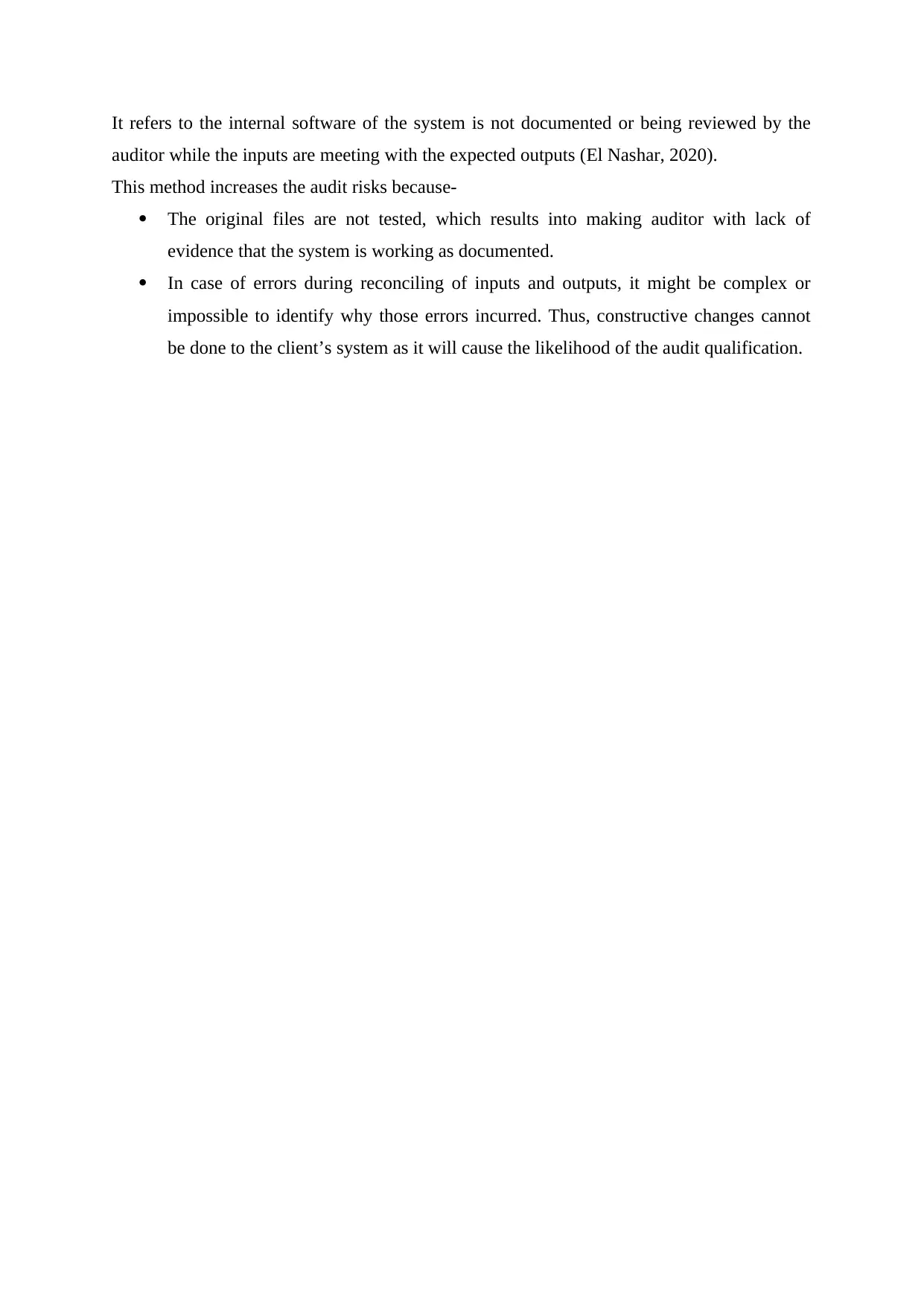
It refers to the internal software of the system is not documented or being reviewed by the
auditor while the inputs are meeting with the expected outputs (El Nashar, 2020).
This method increases the audit risks because-
The original files are not tested, which results into making auditor with lack of
evidence that the system is working as documented.
In case of errors during reconciling of inputs and outputs, it might be complex or
impossible to identify why those errors incurred. Thus, constructive changes cannot
be done to the client’s system as it will cause the likelihood of the audit qualification.
auditor while the inputs are meeting with the expected outputs (El Nashar, 2020).
This method increases the audit risks because-
The original files are not tested, which results into making auditor with lack of
evidence that the system is working as documented.
In case of errors during reconciling of inputs and outputs, it might be complex or
impossible to identify why those errors incurred. Thus, constructive changes cannot
be done to the client’s system as it will cause the likelihood of the audit qualification.
Paraphrase This Document
Need a fresh take? Get an instant paraphrase of this document with our AI Paraphraser
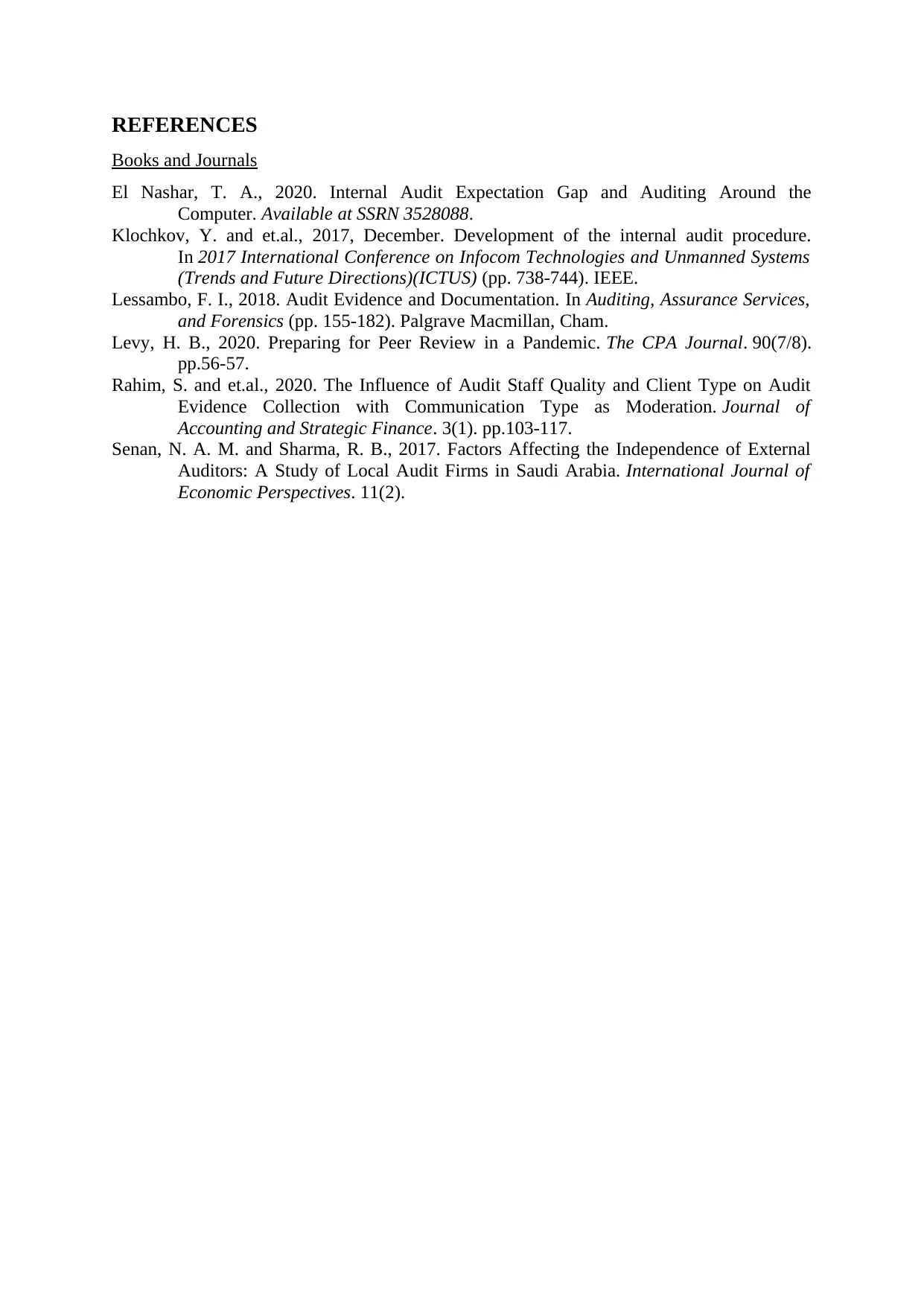
REFERENCES
Books and Journals
El Nashar, T. A., 2020. Internal Audit Expectation Gap and Auditing Around the
Computer. Available at SSRN 3528088.
Klochkov, Y. and et.al., 2017, December. Development of the internal audit procedure.
In 2017 International Conference on Infocom Technologies and Unmanned Systems
(Trends and Future Directions)(ICTUS) (pp. 738-744). IEEE.
Lessambo, F. I., 2018. Audit Evidence and Documentation. In Auditing, Assurance Services,
and Forensics (pp. 155-182). Palgrave Macmillan, Cham.
Levy, H. B., 2020. Preparing for Peer Review in a Pandemic. The CPA Journal. 90(7/8).
pp.56-57.
Rahim, S. and et.al., 2020. The Influence of Audit Staff Quality and Client Type on Audit
Evidence Collection with Communication Type as Moderation. Journal of
Accounting and Strategic Finance. 3(1). pp.103-117.
Senan, N. A. M. and Sharma, R. B., 2017. Factors Affecting the Independence of External
Auditors: A Study of Local Audit Firms in Saudi Arabia. International Journal of
Economic Perspectives. 11(2).
Books and Journals
El Nashar, T. A., 2020. Internal Audit Expectation Gap and Auditing Around the
Computer. Available at SSRN 3528088.
Klochkov, Y. and et.al., 2017, December. Development of the internal audit procedure.
In 2017 International Conference on Infocom Technologies and Unmanned Systems
(Trends and Future Directions)(ICTUS) (pp. 738-744). IEEE.
Lessambo, F. I., 2018. Audit Evidence and Documentation. In Auditing, Assurance Services,
and Forensics (pp. 155-182). Palgrave Macmillan, Cham.
Levy, H. B., 2020. Preparing for Peer Review in a Pandemic. The CPA Journal. 90(7/8).
pp.56-57.
Rahim, S. and et.al., 2020. The Influence of Audit Staff Quality and Client Type on Audit
Evidence Collection with Communication Type as Moderation. Journal of
Accounting and Strategic Finance. 3(1). pp.103-117.
Senan, N. A. M. and Sharma, R. B., 2017. Factors Affecting the Independence of External
Auditors: A Study of Local Audit Firms in Saudi Arabia. International Journal of
Economic Perspectives. 11(2).
1 out of 8
Related Documents
Your All-in-One AI-Powered Toolkit for Academic Success.
+13062052269
info@desklib.com
Available 24*7 on WhatsApp / Email
![[object Object]](/_next/static/media/star-bottom.7253800d.svg)
Unlock your academic potential
Copyright © 2020–2025 A2Z Services. All Rights Reserved. Developed and managed by ZUCOL.





